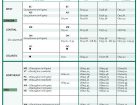
Pellet markets
June 9, 2017
By Keta Kosman / Madison’s Pellet Report
Heating wood pellet consumption for residential purposes in the U.S. takes place largely in the northeast, where pellets compete with other home heating fuels, as above. Heating wood pellets produced in the U.S. west and south are almost entirely for export (EU, Asia), while those produced in the northeast are consumed approximately 50/50 by residential users and for export. Of course American pellets produced in the west or south certainly find their way into the northeast retail market.
In the U.S. west and south, there is not a lot of demand for residential heating wood pellets; for the former because other heating fuels are much more inexpensive and for the latter because home heating is not a large consumer of energy.
Canadian heating wood pellets are almost entirely an export market, also to Asia and EU, with a little bit of demand coming for mostly industrial purposes in Alberta and southern Ontario. Some Canadian pellets are sold to retailers into the U.S., but the domestic U.S. wood pellet industry is largely self-sustaining and has no need to import from Canada.
According to a newly-released report from the U.S. Energy Information Administration (EIA), American manufacturers produced roughly 3 million metric tons and sold 2.8 million metric tons of wood pellets in the first half of 2016. Approximately 82 per cent of sales were utility pellets to export markets, and 85 per cent of that was to the U.K.’s Drax power plant. The remaining 18 per cent were sold to U.S. buyers for residential heating applications. Prices of competing winter-heating fuels were relatively low in early 2016 compared to those of densified biomass. Utility-grade pellets for use by electrical utilities accounted for more than 75 per cent of total pellet production in the U.S. Utility-pellets were almost entirely produced by the southern states, while eastern and western states produced most of those for residential-use. Western states accounted for less than half of residential heating pellet production than eastern states.
According to a newly-released report from the EIA, during the first half of 2016, U.S. manufacturers produced approximately 3.3 million tons of wood pellets and sold 3.1 million tons, mostly to foreign markets, according to data from EIA’s newly released Densified Biomass Fuel Report.
Wood pellet fuel, also known as densified biomass fuel, is used for electric power generation and for domestic heating needs. About 85 per cent of raw materials for biomass pellets come from wood waste streams such as logging residues, sawmill residues, and wood product manufacturing residue. Roundwood timber – generally logs harvested for industrial use – account for about 15 per cent of raw materials.
According the to U.S. Energy Information Administration’s Winter Fuels Outlook released March 7, the number of households in the U.S. using cord wood or wood pellets as the primary residential space heating fuel has increased by 26 per cent since 2005, to about 2.5 million households in 2015. About eight per cent of households use wood as a secondary source of heat, making wood second only to electricity as a supplemental heating fuel.
About 20 per cent of homes in New England (1.1 million) used wood for space heating, water heating, or cooking in 2009, which is nearly twice the national rate.
Most of the fibre supply delivered to pellet and chipmills is harvested as small-diameter, tree-length logs classified as “pulpwood,” as well as the top stemwood portion (or “topwood”) of larger-diameter logs classified as “sawtimber.” Pulpwood and topwood are harvested most frequently at 151 million metric tons, while sawtimber is harvested at 115 million metric tons, says Forest2Market in its US South Biomass Feedstock Supply for Asian Biopower Producers published March 1.
The Asian market is maturing towards long-term supply contract structure of industrial wood pellets, and can be cost-competitively supplied from the southeastern U.S., said Enviva Partners in their Business Overview published February 27. In Japan, nearly 3.2 GW of biomass-red capacity, implying demand of more than 10 million MTPY of biomass, have been approved through the feed-in tariff program, of which approximately 500 MWs are commissioned. The Japanese government has set a target of 6.0 – 7.5 GWs of biomass-fired capacity by 2030.
Primary energy consumption in the U.S. in 2016 totalled 97.4 quadrillion British thermal units (Btu), a slight increase from the 2015 level, said a U.S. EIA’s news release. Consumption of coal decreased by nine per cent, nearly offsetting increases in the consumption of renewables, petroleum, natural gas, and nuclear fuel. U.S. primary energy production, meanwhile, totalled 84.1 quadrillion British thermal units (Btu) in 2016, falling four per cent from the 2015 level, the first annual decline in U.S. energy production since 2009, according to EIA March 31. The decline in production coincided with an increase in both total energy imports and exports.
As publisher of the weekly lumber industry newsletter Madison’s Lumber Reporter, Keta Kosman covers breaking news for the softwood lumber market. Madison’s has been providing quality news and price information about Canadian softwood lumber products since 1952. For over 60 years, they’ve built a reputation as an independent, opinionated, always right-on source of market news. In 2017 Madison’s launched a brand-new product, the monthly Heating Wood Pellet Report. Learn more and sign up at
www.madisonsreport.com/madisons-wood-pellet-report
Print this page
